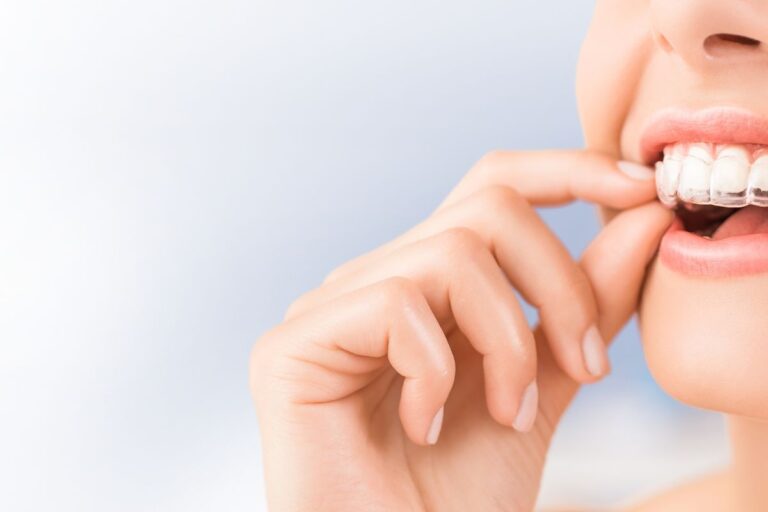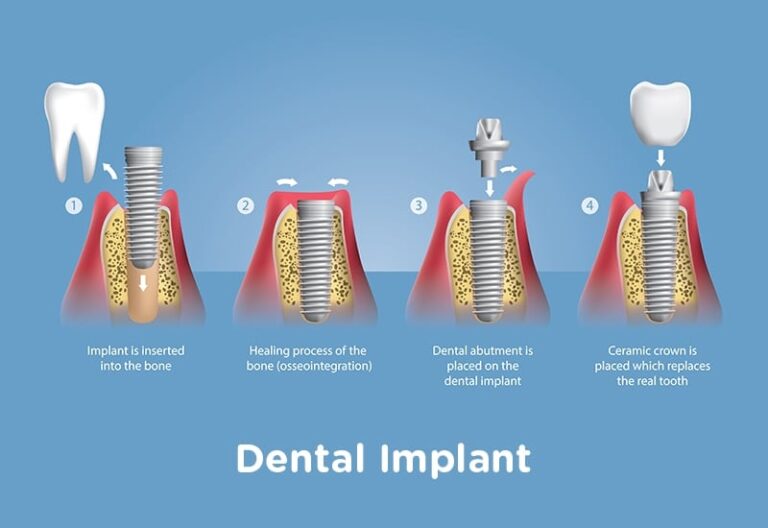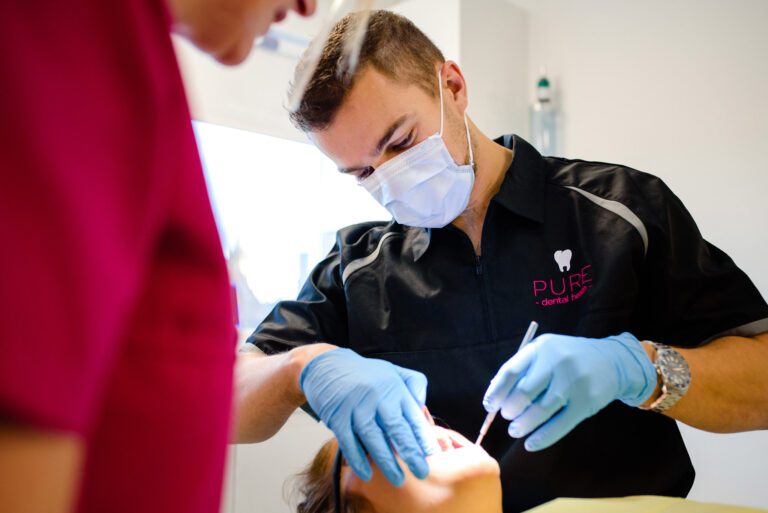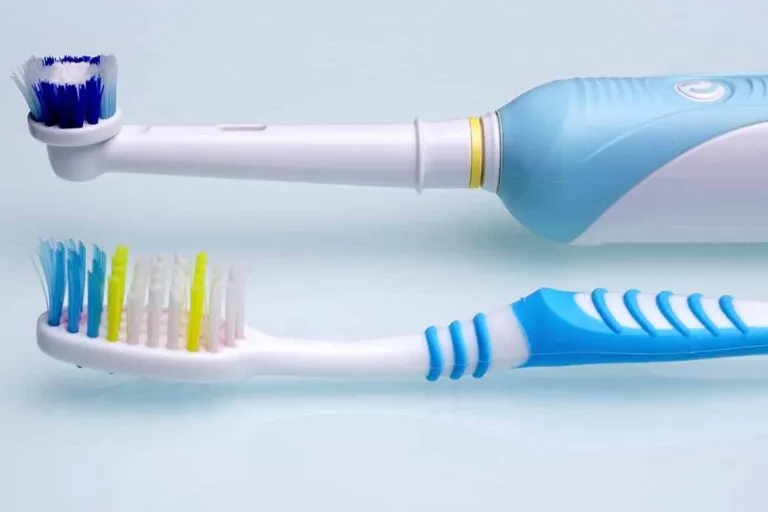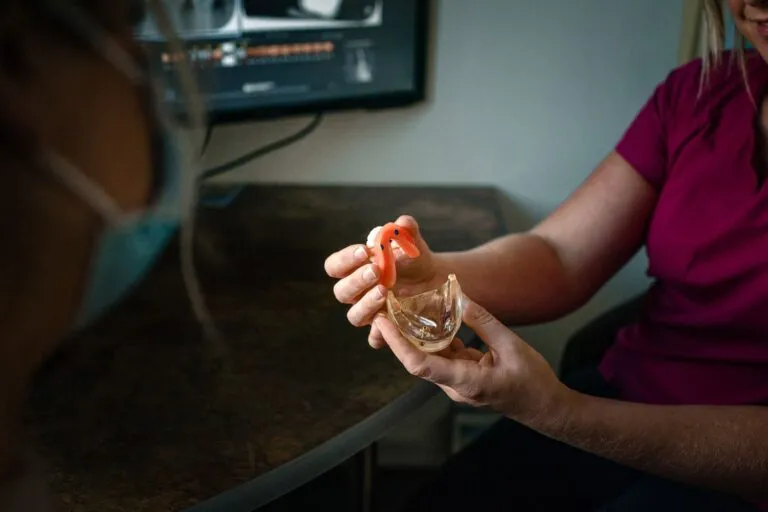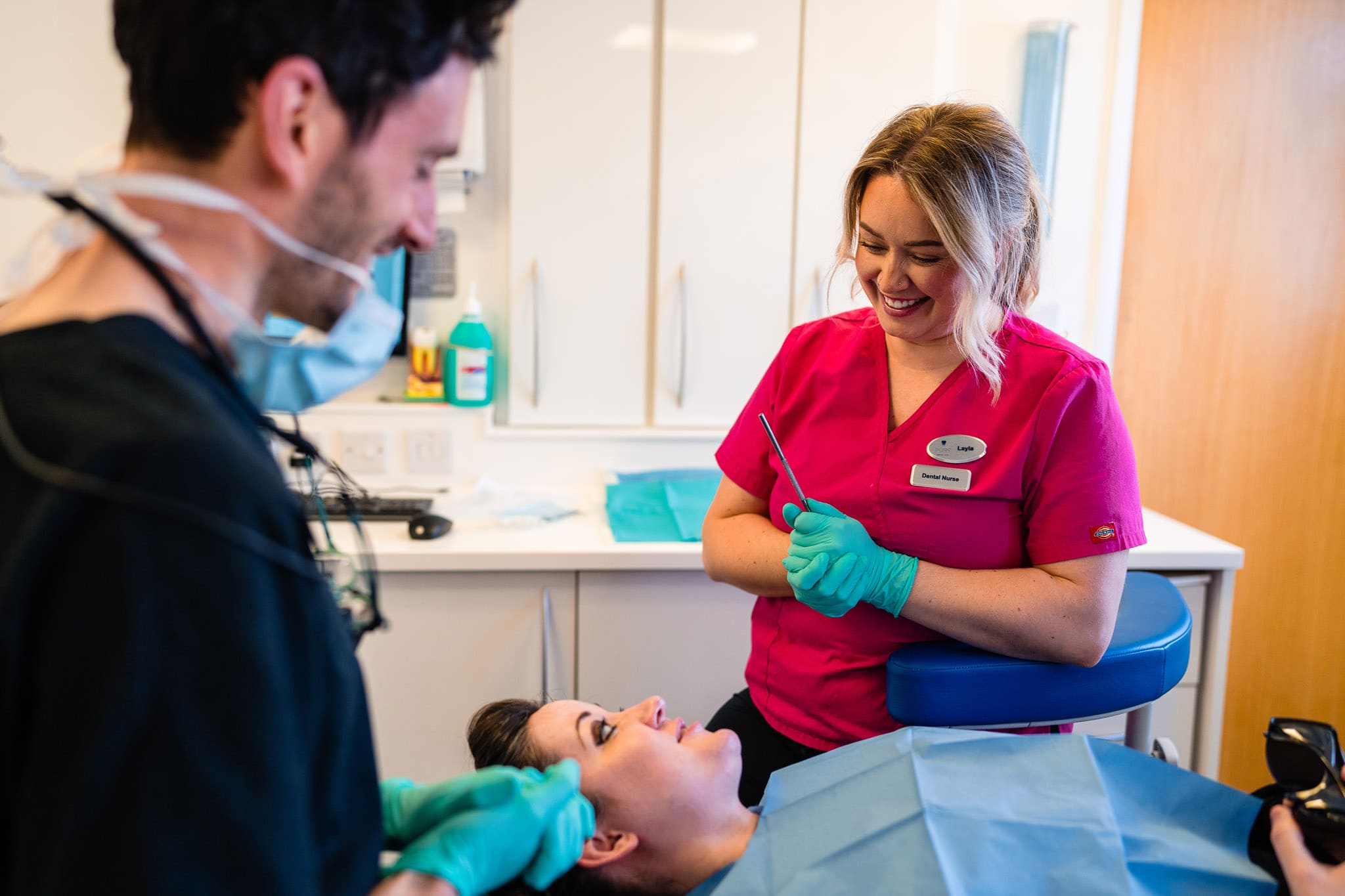Understanding the difference between Invisalign vs braces is one of the most common dilemmas facing patients considering treatments to straighten their teeth.
Whether you’re an adult seeking a discreet teeth straightening solution or a parent researching the best option for your teenager, understanding the key differences between these two orthodontic treatments is crucial for making an informed decision.
At Pure Dental in Truro, we understand that orthodontic treatments are a significant investment in your oral health. With extensive experience in both Invisalign and traditional braces, our team is here to guide you through this important choice and ensure you choose the right option for you.
It’s essential to note that although some patients may consider invisible braces or Invisalign their preferred option from an aesthetic perspective, this may not be suitable for the movements required to achieve the beautiful smile you desire. This is why a personal assessment with Mike (our dentist with a special interest in orthodontics) is needed to give you the best advice for you
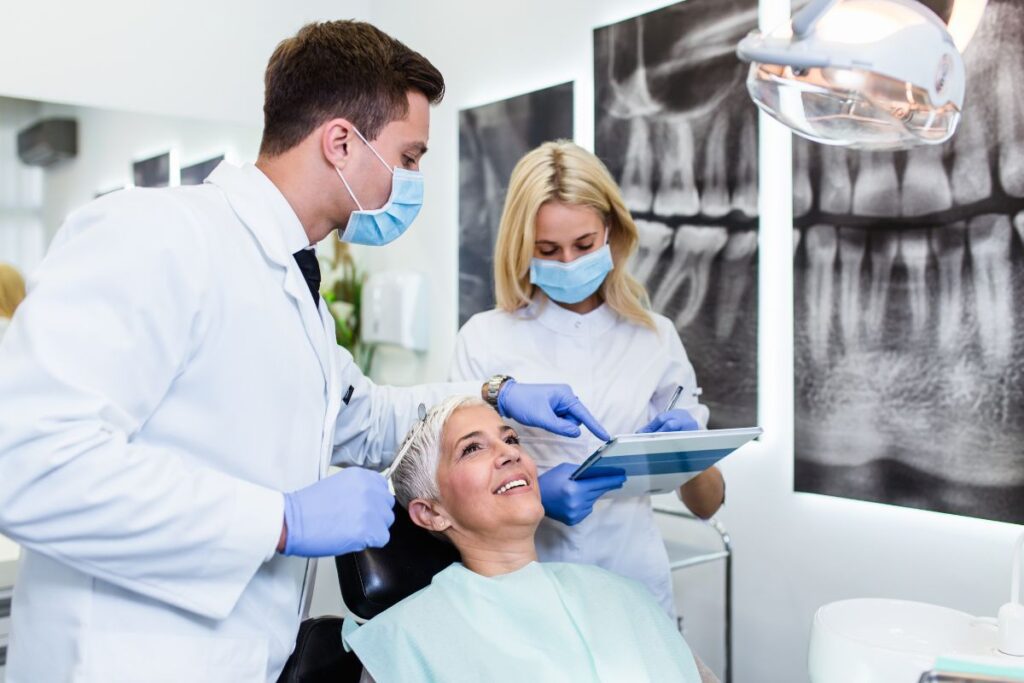
Invisalign vs Braces: Key Differences
If you’re asking the question “Which is best, Invisalign vs braces?” then let us help by highlighting the key differences between each. Whilst both will undoubtedly improve your smile, making an informed decision means you’ll be better prepared when the time comes.
Invisalign was created to straighten your teeth without the need for brackets and wires typically associated with traditional braces. Instead, you wear clear, nearly invisible trays – called aligners – that gradually move your teeth into position.
Traditional braces use fixed metal or ceramic brackets with wires that remain attached to teeth throughout treatment. Invisalign typically offers greater comfort and convenience but may cost more than conventional metal braces.
This Invisalign vs. braces comparison highlights the fundamental differences between the two treatments, helping you understand which option might better suit your lifestyle and orthodontic needs.
| Aspect | Invisalign | Traditional Braces |
| Appearance | Nearly invisible clear aligners | Visible metal brackets and wires |
| Removability | Completely removable | Fixed to teeth throughout treatment |
| Comfort | Smooth plastic, minimal irritation | May cause discomfort from brackets/wires |
| Eating | No food restrictions (remove to eat) | Avoid hard, sticky, chewy foods |
| Cleaning | Remove to brush/floss normally | Special cleaning around brackets required |
| Check-ups | Every 6-8 weeks | Every 4-6 weeks for adjustments |
| Treatment Time | 12-18 months average | 18-24 months average |
| Cost Range | £3,500-£5,500 | £2,500-£4,500 |
| Best For | Mild to moderate cases | Complex cases, severe crowding |
| Compliance | Requires 22 hours of daily wear | No patient compliance needed |
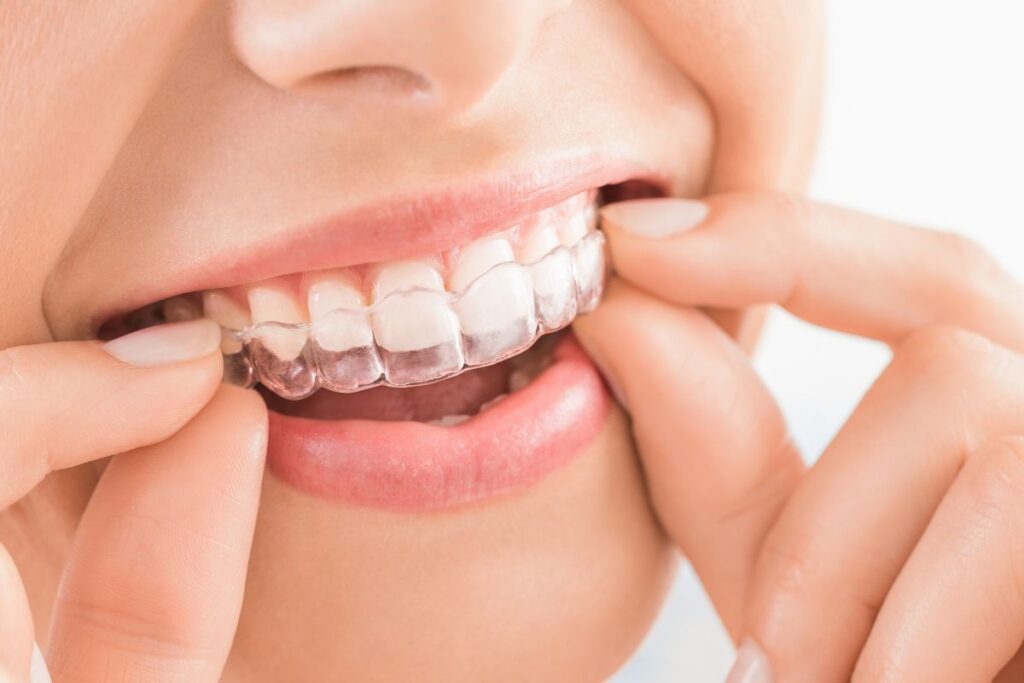
Appearance and Aesthetics
One of the most significant differences between Invisalign and braces lies in their visibility.
- Invisalign aligners are made from virtually invisible, medical-grade plastic, making them barely noticeable when worn. This makes them particularly popular among adults and image-conscious teenagers who want to straighten their teeth discreetly.
- Metal braces, while highly effective, are more noticeable due to their metal brackets and wires. Ceramic braces offer a more aesthetic alternative with tooth-coloured brackets, although they are more noticeable than Invisalign and typically cost more than standard metal braces.
Comfort and Convenience
Invisalign generally provides a more comfortable treatment experience due to its smooth plastic construction, which eliminates the mouth sores and irritation sometimes associated with metal brackets and wires.
You can remove your aligners and eat normally with Invisalign, whilst braces require avoiding hard, sticky, or chewy foods that could damage the appliance. This removability also makes oral hygiene significantly easier with Invisalign, as patients can brush and floss their teeth normally.
However, this convenience comes with the responsibility of wearing aligners for 20-22 hours a day to ensure effective treatment, requiring strong patient compliance that isn’t necessary with fixed braces.
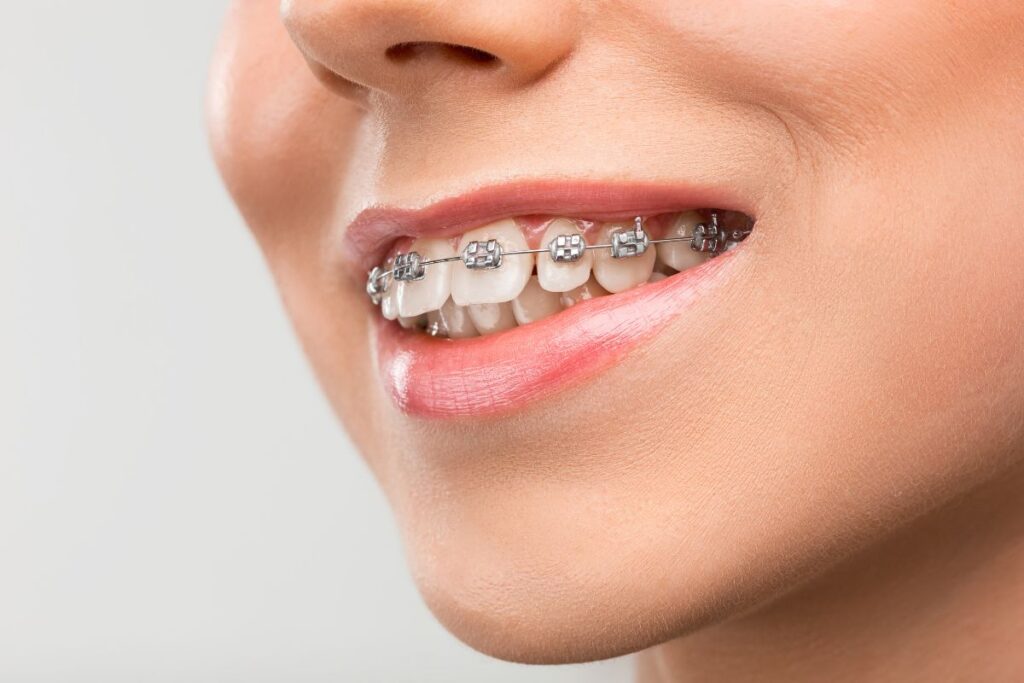
Treatment Process
The treatment process differs considerably between these two options:
- Invisalign treatment begins with creating digital impressions and 3D treatment planning, enabling patients to preview their expected results before treatment starts. Patients receive multiple sets of aligners to change weekly or bi-weekly at home, with check-ups every 6-8 weeks to monitor progress.
- Traditional braces involve bonding brackets to the teeth during the initial appointment, followed by regular adjustment visits every 4-6 weeks to tighten the wires. While braces require more frequent office visits, they work continuously without relying on patient compliance, making them often more predictable for complex cases requiring significant tooth movement.
Cost Comparison: Invisalign vs Traditional Braces
Comparing the cost of Invisalign vs braces is crucial when you’re looking at which option will be best for you. Teeth straightening costs can vary considerably based on treatment complexity and duration. Here at Pure Dental, we pride ourselves on always being open and upfront with our dental pricing to give our patients ultimate peace of mind and transparency.
Invisalign Treatment Costs
At Pure Dental, we treat every patient as an individual; therefore, each orthodontic treatment is entirely bespoke.
The cost of Invisalign treatment typically starts at £2600. We also offer invisible braces for minor corrections, starting at £2000.
The final cost depends on several factors, including the complexity of your case, the duration of treatment, and whether additional refinements are required. The price will include all Invisalign aligners, retainers, and follow-up appointments throughout your treatment.
Traditional Braces Pricing
Traditional metal braces prices start at £1800, making them typically more affordable than Invisalign. Ceramic braces with tooth-coloured brackets start at £2800. We offer all patients a complimentary treatment consultation to ensure you make the right decision for your needs and lifestyle.
Insurance and Payment Options
Any dental treatments are entirely individual for you and your budget. We know that orthodontic treatments can present a significant investment, which is why we offer our patients the flexibility of dental finance options to spread the cost of their dental care. Our dental payment plans make treatment more accessible, allowing you to spread costs over 12-24 months with low or no-interest options.
While cost is an important consideration, it’s also important to remember that orthodontic treatment is an investment in your long-term oral health, confidence, and overall quality of life, providing benefits for decades to come.
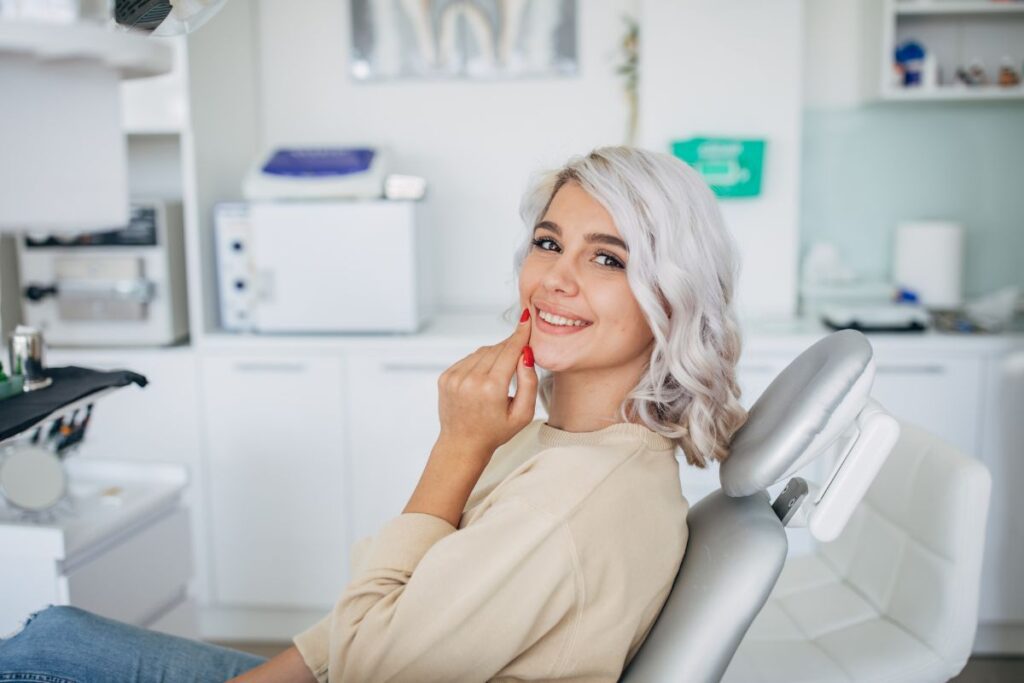
Treatment Time: How Long Does Each Option Take?
Treatment duration is often a deciding factor for patients deliberating between Invisalign vs braces. While both treatments can achieve excellent results, the timeline for each varies based on how quickly your teeth move into their ideal positions.
Invisalign Timeline
Invisalign treatment typically takes 12-18 months for most patients, with some simple cases completed in as little as 6-9 months.
The treatment involves changing to a new set of aligners every 1-2 weeks, with each set making small, controlled movements to gradually shift your teeth. Most patients require between 20 and 40 sets of aligners throughout their treatment, although complex cases may need 50 or more.
Braces Treatment Duration
Traditional braces generally require 18-24 months of treatment, though simple cases may be completed in 12-15 months, and complex cases can extend to 30-36 months.
The treatment timeline is determined by the severity of misalignment, age of the patient, and how well the teeth respond to the applied forces. Younger patients often see faster results as their bones are still developing, while adult treatment may take longer due to slower bone remodelling.
Factors That Affect Treatment Speed
Your orthodontist will assess these factors during consultation to provide a realistic timeline estimate for your specific situation.
- Case complexity is the primary determinant – minor crowding or spacing issues resolve faster than severe bite problems or rotated teeth.
- Biological factors, such as bone density and individual healing responses vary between patients, making some naturally faster responders than others.
- Treatment goals also matter – achieving basic alignment is quicker than perfecting bite relationships or making significant jaw corrections.

Effectiveness: Which Works Better?
Both Invisalign and traditional braces are highly effective orthodontic treatments, but their success depends largely on choosing the right option for your specific dental needs. Understanding which treatment is most effective in different scenarios will help you make an informed decision about your orthodontic care.
Cases Best Suited for Invisalign
Invisalign works exceptionally well for mild to moderate orthodontic issues, particularly cases involving crowding, spacing, and minor bite problems. Adults with relapsed teeth from previous orthodontic treatment often find Invisalign ideal for fine-tuning their smiles.
- Closing small to moderate gaps between teeth
- Correcting mild overcrowding
- Addressing minor overbites or underbites
- Treating rotated teeth
When Traditional Braces Are Preferred
Traditional braces remain the gold standard for complex orthodontic cases and are often preferred when significant tooth movement is required. Young patients with developing jaws usually benefit more from braces, as they can guide jaw growth more effectively.
- Severe crowding or large gaps
- Significant bite corrections
- Cases requiring substantial vertical tooth movement.
- Complex bite problems such as severe overbites, underbites, crossbites, and open bites
- Rotating severely twisted teeth, especially canines and premolars
Treatment Success Rates
Both Invisalign and traditional braces boast high success rates when used appropriately for suitable cases.
Studies show that traditional braces achieve successful outcomes in approximately 90% of cases, with their effectiveness being well-documented over decades of use. Invisalign demonstrates similarly high success rates for appropriate cases, with patient compliance being the primary factor affecting outcomes.
Ultimately, both treatments can deliver beautiful, healthy smiles when recommended by experienced orthodontists who carefully evaluate each patient’s specific needs and select the most appropriate treatment option.

Invisalign vs Braces: Lifestyle Considerations
Your choice will significantly impact your daily routine, social interactions, and professional life. Understanding how each option fits into your lifestyle is crucial for ensuring successful outcomes.
Daily Maintenance and Care
Invisalign requires a dedicated daily routine that becomes second nature with practice! You’ll need to remove your aligners before eating or drinking anything other than water, clean them regularly with lukewarm water and gentle soap, and brush your teeth after every meal before reinserting them. This process typically adds 10-15 minutes to your daily routine but ensures optimal hygiene and aligner clarity.
Traditional braces demand more complex oral hygiene practices, requiring special floss threaders, interdental brushes, and potentially water flossers to clean around brackets and wires effectively. Brushing takes longer and requires careful attention to remove food particles and plaque buildup around the hardware. However, once you master the cleaning routine, braces require no additional daily management tasks, such as removing and reinserting appliances.
Dietary Restrictions
One of Invisalign’s greatest advantages is the complete dietary freedom it offers. Since aligners are removed for eating, you can enjoy all your favourite foods without restriction – from crunchy apples and nuts to sticky caramel and chewy sweets. The only requirement is thorough teeth cleaning before reinserting aligners to prevent staining and decay.
Traditional braces come with a comprehensive list of foods to avoid, including hard items like ice, nuts, and hard candies that can break brackets, sticky foods like caramel and gum that can get trapped, and chewy items like bagels that can bend wires. You’ll also need to cut corn off the cob, slice apples into smaller pieces, and avoid biting into hard foods with your front teeth. While these restrictions may seem limiting initially, most patients adapt well and discover new food preparation methods and healthier eating habits during treatment.
Professional and Social Impact
Invisalign offers distinct advantages for adults concerned about their appearance. The clear aligners are virtually invisible, allowing you to maintain a polished professional image throughout treatment. Speech changes are minimal and typically resolve within days, though some patients experience a slight lisp initially. For special events, aligners can be temporarily removed for photos or important occasions, though this should be done sparingly to maintain treatment progress.
Traditional braces are more noticeable and may impact how some adults perceive their professional appearance, particularly in client-facing roles. However, attitudes toward adult orthodontics have evolved significantly, and many professionals successfully navigate treatment with confidence. Braces may cause initial speech changes and occasional mouth sores, which can affect comfort during long meetings or presentations. For teenagers, peer acceptance varies, though braces are increasingly common and socially accepted among young people, while some may prefer the discretion that Invisalign provides during important social events or activities.
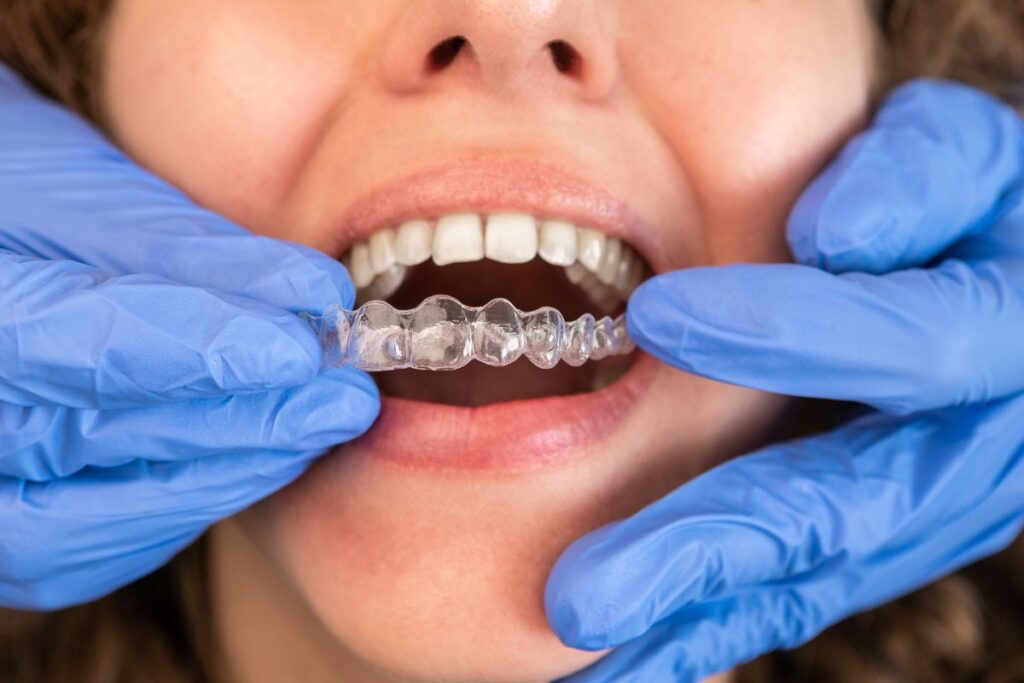
Making the Right Choice for Your Smile
Invisalign vs traditional braces isn’t a one-size-fits-all decision. Selecting the ideal orthodontic treatment requires careful consideration of your unique circumstances, lifestyle, and treatment goals.
Adult Orthodontic Considerations
Adults considering orthodontic treatment face unique factors that influence their treatment choice. Professional image often takes priority, making Invisalign’s discretion particularly appealing for those in client-facing roles where appearance matters.
Adult bone density is different from that of teenagers, meaning tooth movement may be slower and require more precise control, which sometimes favours traditional braces for complex cases.
Adults are typically more motivated to maintain excellent oral hygiene and follow treatment protocols precisely, making them ideal candidates for Invisalign when clinically appropriate. However, many adults have existing dental work like crowns, bridges, or previous orthodontic treatment that may influence which option will be most effective.
Teen Orthodontic Treatment Options
Teenagers present different considerations when deciding on Invisalign vs braces. Social confidence during formative years is crucial, and while attitudes toward braces have improved significantly, some teens strongly prefer the discretion of Invisalign to avoid feeling self-conscious during school photos, dances, or social events.
The NHS services are overwhelmed, and we can provide a faster service with no waiting list, which might make our teen orthodontic treatments an attractive option for you and your family.
It’s important to remember that compliance can sometimes be challenging for busy teenagers, who may forget to wear aligners consistently or lose them during school activities (Invisalign can be removed for sports, but must be consistently replaced afterwards).
Traditional braces eliminate compliance concerns while still delivering excellent results, and many teens appreciate not having the responsibility of managing removable appliances. Parent involvement often influences teen treatment success, as supervision and encouragement help ensure compliance with either treatment option.
Questions to Ask Your Orthodontist
When you book a consultation with Pure Dental, we will discuss the specific complexity of your case and recommend the most effective treatment for your particular dental issues. We’ll advise on realistic treatment timelines for both options, as well as the factors that might extend or shorten your treatment duration.
We will also advise you on what happens if problems arise – such as lost aligners, broken brackets, or if progress is slower than expected.
Our dentists will then provide you with a detailed treatment plan that shows expected outcomes, allowing you to make an informed decision based on realistic expectations.
Conclusion
Whether you choose Invisalign or braces, one thing is for sure- your best interests are at the heart of everything we do here at Pure Dental. We are now welcoming new private patients in our beautiful relaxing Truro clinic so why not get in touch and see if our teeth straightening treatments can help you achieve a more confident smile? Our experienced, professional dentistry team can’t wait to meet you and help make your dental dreams come true.

Invisalign vs Braces: Frequently Asked Questions
Which is better, braces or Invisalign?
Neither is universally “better” – the best choice depends on your specific case. Invisalign excels in addressing mild to moderate alignment issues, offering superior aesthetics and convenience. Traditional braces are more effective for complex cases, severe crowding, and significant bite corrections.
What are the negatives of Invisalign?
The main drawbacks include higher cost, requiring strict compliance, potential for lost aligners, and limited effectiveness for complex orthodontic problems.
Why do people quit Invisalign?
Most discontinuations occur due to poor compliance – forgetting to wear aligners consistently, losing them frequently, or finding the daily routine too demanding. Some patients also quit if they don’t see progress quickly enough.
Why don’t all dentists recommend Invisalign?
Some dentists prefer braces for complex cases where precise control is needed.. Not all practitioners have extensive Invisalign training like we do here at Pure Dental, so may prefer the predictability of traditional methods for challenging cases.
Which is faster, Invisalign or braces?
Invisalign typically takes 12-18 months, while braces require 18-24 months. However, treatment speed depends more on case complexity than on the method chosen. Simple cases may be faster with Invisalign, while complex cases often progress more predictably with braces.
Is Invisalign more expensive than braces?
Yes, Invisalign generally costs more than traditional braces. The price difference reflects the advanced technology, custom manufacturing, and convenience factors, though costs vary by practice and case complexity.
Can you eat normally with Invisalign vs braces?
Invisalign allows complete dietary freedom since aligners are removed for eating. Traditional braces require avoiding hard, sticky, or chewy foods that could damage brackets and wires.
Do you need to wear a retainer after Invisalign vs braces?
Yes, both treatments require wearing a retainer to maintain the results. The retention protocol is identical regardless of treatment type – typically full-time initially, then nights only long-term to prevent teeth from shifting back.


